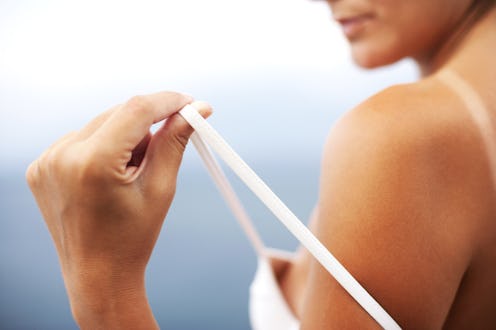Life
6 Ways to Get The Most of Your Sunscreen

Skin cancer is the most common type of cancer in the US. To help avoid it, we've got a pretty solid foundation of sunscreen habits: when the sun is out, sunscreen is in; during the sun's peak hours we sprint (ok, more like stroll because it's too hot) to the shade and always don sunglasses and a wide-brimmed hat; and we know that for now, drinkable sunscreen can't replace the regular stuff. But even with these great habits under our belt, there is still so much more that can be done. Sunscreen use isn't rocket science—slather on and go, right?—but it's actually easy to slip up and end up with a burn, or worse.
We enlisted the help of two top dermatologists to set some summer SPF rules. Ahead, their advice on how to make it through summer sans burns, spots, or skin damage.
You need sunscreen always.
Yes, even if you are chained to your desk under the glare of fluorescent lights, SPF still needs to be part of your daily regimen. "Sun damage can occur during indoor activities, on cloudy days, and in the winter, as the sun can come through the windows and reflect off surfaces," explains Dr. Howard Murad, M.D., associate clinical professor of dermatology at UCLA and founder of the Murad skin care line. To get covered at the office, look for a moisturizer with at least SPF 15 and both UVA and UVB protection. If you truly won't be seeing the light of day (no grabbing lunch outside, no windows next to your desk), it's ok to just do one application in the morning. "But I always recommend that my patients do reapply 15 to 20 minutes prior to heading home because the late afternoon light during your commute home can quickly damage skin," says Beverly Hills-based Dr. Harold Lancer, M.D., whose client list includes Beyonce and Scarlett Johansson.
Murad notes that those with sensitive skin or a tendency to crisp easier should take it up a notch to SPF 30. And if you're spending a good chunk of time outdoors—hello summer Fridays!—re-apply a shot-glass amount every two hours.
Sunscreen isn't just a 9 to 5 deal.
Slipping off to a rooftop happy hour after work? Slather on some SPF. "The beautiful light of the sunset can be just as damaging as the rays at high noon," says Lancer.
SPF 50 does not equal 50 minutes in the sun.
Quick lesson in SPF: It stands for Sun Protection Factor, and refers to the amount of UV radiation that it will take to burn unprotected skin. The trick: it's not the number of minutes of protection, rather the intensity of the level of protection against rays. "This is not an absolute rule. Other factors like the skin type of the user, ethnicity, the amount of sunscreen applied, how strong the sun is, and the frequency of reapplication all contribute to how quickly burning will actually occur," says Lancer.
There is no such thing as “waterproof” sunscreen.
Your favorite mascara might hold up through a lengthy pool session, but sunscreen isn't all that resistant. Using the "w" word on sunscreen labels is actually forbidden by the FDA because there are no sunscreens that are truly 100 percent waterproof, notes Lancer. Should you find yourself pool or beach side, you best bet is to pick up a "water resistant" one and reapply, reapply, reapply—every 40 or 80 minutes, depending on the bottle, Murad advises.
Skip the spray-on versions.
We love anything that's easy and takes seconds to use, but spray-on sunscreen is one of those investments that doesn't have much return. "The light formula and method of application mean there is a much greater chance for missing areas and getting burned. Additionally, the chemicals in the SPF mists are absolutely not meant to be inhaled in our lungs," explains Lancer. Recently, the FDA deemed spray-on sunscreens dangerous for children, and the American Academy of Dermatology says to use spray with caution, so let's all stick to a cream-based for now.
Dark skin needs sun protection too.
Many years ago the thinking was that anyone whose skin was olive and beyond could ditch sunscreen altogether and just bask in the sun forever with their superior genes. Unfortunately, science has since debunked this lofty idea. "Dark skin is just as susceptible to the damaging UVA and UVB rays and in fact, the darker tones may make it more difficult to spot precancerous or cancerous growths," Lancer says. Not matter what your skin tone, don't leave the house without it.
Image Credit: Markomarcello/Fotolia